Page 1898 of 3371
INTAKE MANIFOLD
EM-15
C
D
E
F
G
H
I
J
K
L
MA
EM
Revision: August 20072004 QX56
INTAKE MANIFOLDPFP:14003
Removal and InstallationEBS00ILF
REMOVAL
1. Partially drain the engine coolant. Refer to MA-12, "DRAINING ENGINE COOLANT" .
WAR NIN G:
To avoid the danger of being scalded, never drain the engine coolant when the engine is hot.
2. Remove the engine room cover using power tool. Refer to EM-11, "
REMOVAL" .
3. Release the fuel pressure. Refer to EC-46, "
FUEL PRESSURE RELEASE" .
4. Remove the air duct and resonator assembly. Refer to EM-14, "
REMOVAL" .
5. Disconnect the fuel tube quick connector on the engine side.
1. Intake manifold 2. PCV hose 3. Gasket
4. Electric throttle control actuator 5. Water hose 6. Water hose
7. PCV hose 8. EVAP hose 9. EVAP canister purge control sole-
noid valve
10. Bracket 11. Gasket
KBIA2461E
LBIA0395E
Page 1901 of 3371
EM-18Revision: August 2007
INTAKE MANIFOLD
2004 QX56
5. Install the quick connector cap on the quick connector joint (on
engine side only).
6. Install the fuel hose and tube to hose clamps.
7. Refill the engine coolant. Refer to MA-13, "
REFILLING ENGINE
COOLANT" .
INSPECTION AFTER INSTALLATION
�After installing fuel tubes, make sure there is no fuel leakage at connections in the following steps.
–Apply fuel pressure to fuel lines with turning ignition switch ON (with engine stopped). Then check for
fuel leaks at connections.
–Start the engine and rev it up and check for fuel leaks at connections.
�Perform procedures for “Throttle Valve Closed Position Learning” after finishing repairs. Refer to EC-44,
"Throttle Valve Closed Position Learning" .
�If electric throttle control actuator is replaced, perform procedures for “Idle Air Volume Learning” after fin-
ishing repairs. Refer to EC-44, "
Idle Air Volume Learning" .
SBIA0354E
Page 1912 of 3371
FUEL INJECTOR AND FUEL TUBE
EM-29
C
D
E
F
G
H
I
J
K
L
MA
EM
Revision: August 20072004 QX56
FUEL INJECTOR AND FUEL TUBEPFP:16600
Removal and InstallationEBS00ILK
CAUTION:
Do not remove or disassemble parts unless instructed as shown.
REMOVAL
1. Remove the engine room cover using power tool. Refer to EM-11, "REMOVAL" .
2. Release the fuel pressure. Refer to EC-46, "
FUEL PRESSURE RELEASE" .
3. Disconnect the negative battery terminal.
4. Disconnect the fuel injector harness connectors.
5. Disconnect the fuel hose assembly from the fuel tubes (right bank and left bank).
CAUTION:
�Plug the fuel hoses to prevent fuel from draining.
�Do not separate the fuel connector and fuel hose.
6. Remove the fuel injectors with the fuel tube assembly.
1. Fuel tube (right bank) 2. Cap 3. Fuel damper
4. O-ring 5. O-ring (Blue) 6. Fuel injector
7. Clip 8. O-ring (Brown) 9. O-ring
10. Fuel hose assembly 11. Fuel tube (left bank)
KBIA2472E
Page 1913 of 3371
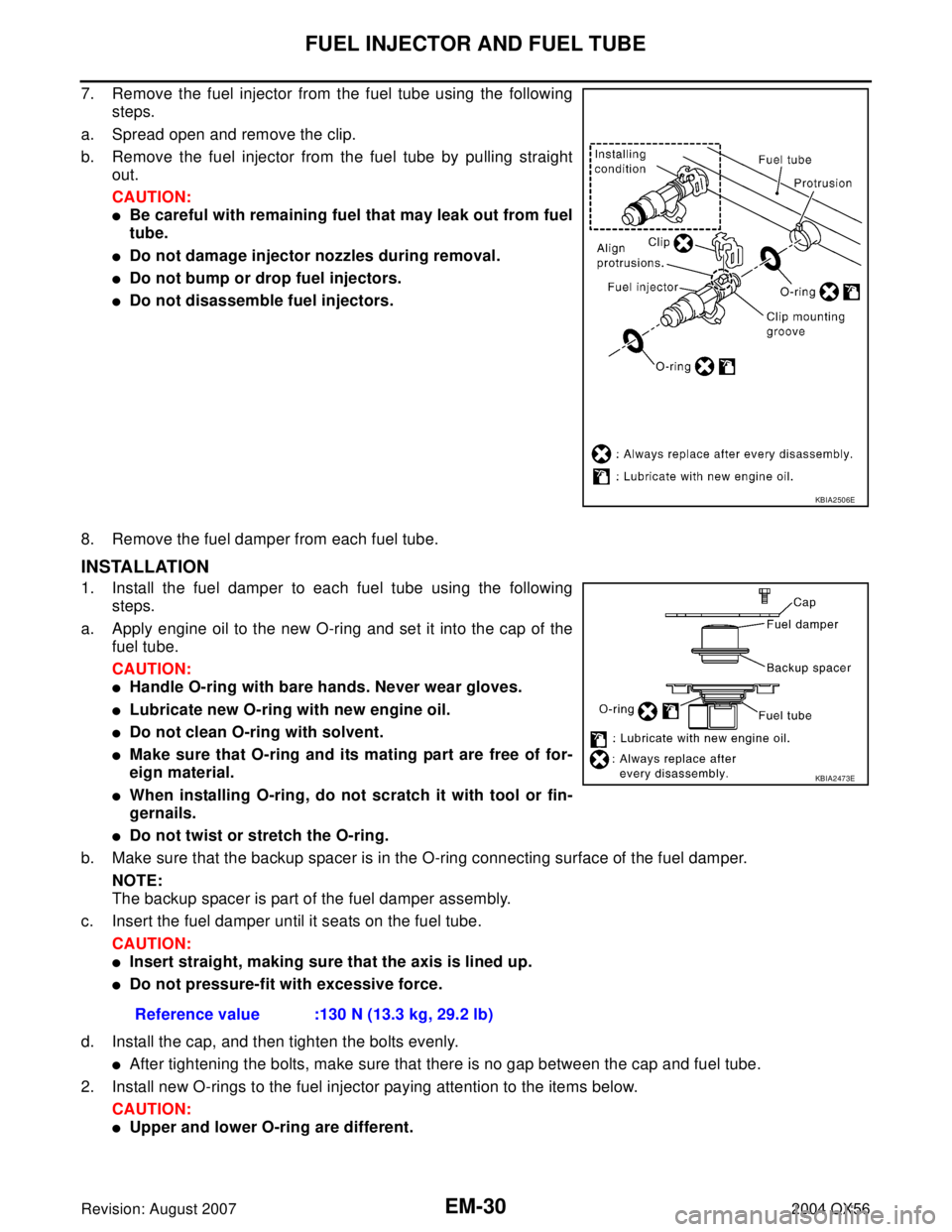
EM-30Revision: August 2007
FUEL INJECTOR AND FUEL TUBE
2004 QX56
7. Remove the fuel injector from the fuel tube using the following
steps.
a. Spread open and remove the clip.
b. Remove the fuel injector from the fuel tube by pulling straight
out.
CAUTION:
�Be careful with remaining fuel that may leak out from fuel
tube.
�Do not damage injector nozzles during removal.
�Do not bump or drop fuel injectors.
�Do not disassemble fuel injectors.
8. Remove the fuel damper from each fuel tube.
INSTALLATION
1. Install the fuel damper to each fuel tube using the following
steps.
a. Apply engine oil to the new O-ring and set it into the cap of the
fuel tube.
CAUTION:
�Handle O-ring with bare hands. Never wear gloves.
�Lubricate new O-ring with new engine oil.
�Do not clean O-ring with solvent.
�Make sure that O-ring and its mating part are free of for-
eign material.
�When installing O-ring, do not scratch it with tool or fin-
gernails.
�Do not twist or stretch the O-ring.
b. Make sure that the backup spacer is in the O-ring connecting surface of the fuel damper.
NOTE:
The backup spacer is part of the fuel damper assembly.
c. Insert the fuel damper until it seats on the fuel tube.
CAUTION:
�Insert straight, making sure that the axis is lined up.
�Do not pressure-fit with excessive force.
d. Install the cap, and then tighten the bolts evenly.
�After tightening the bolts, make sure that there is no gap between the cap and fuel tube.
2. Install new O-rings to the fuel injector paying attention to the items below.
CAUTION:
�Upper and lower O-ring are different.
KBIA2506E
Reference value :130 N (13.3 kg, 29.2 lb)
KBIA2473E
Page 1915 of 3371
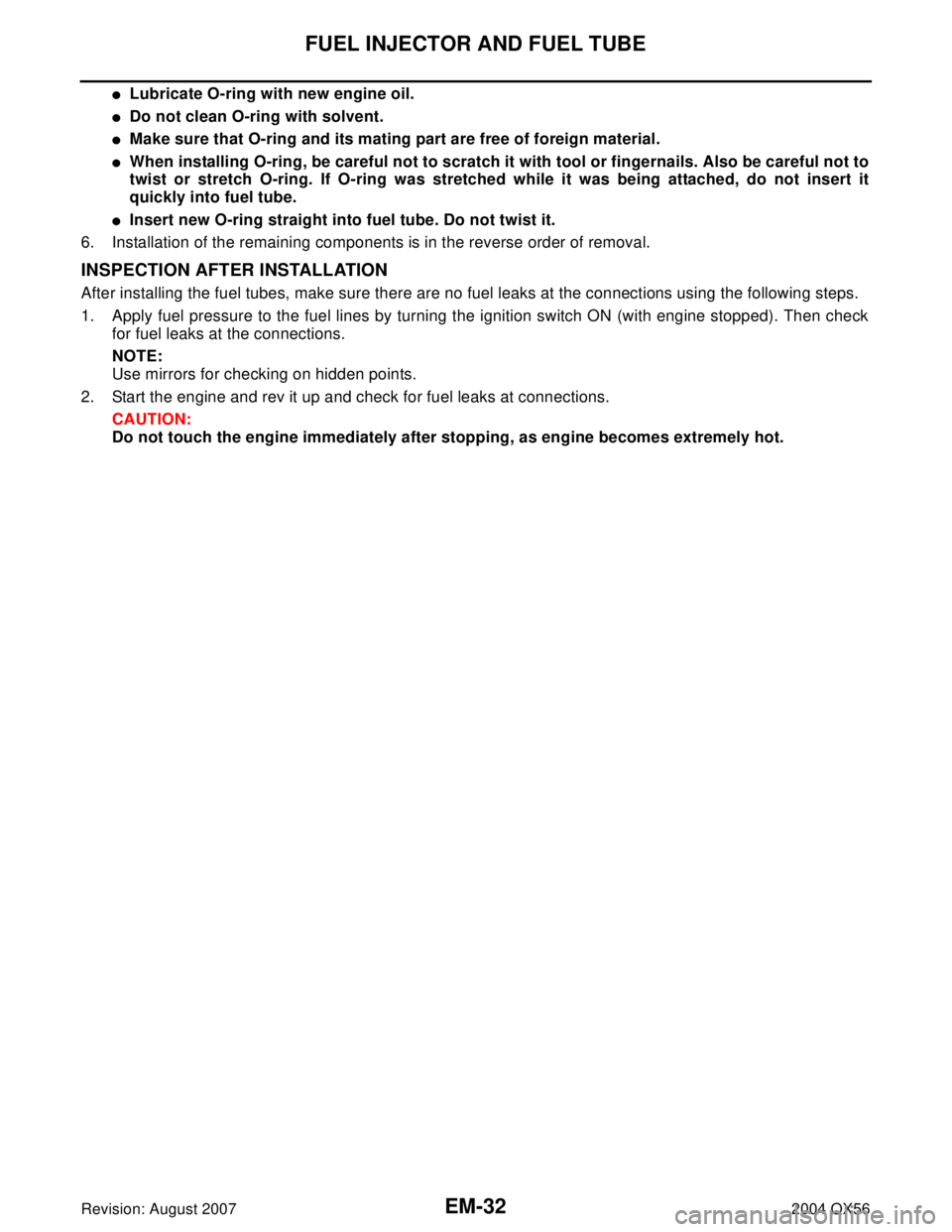
EM-32Revision: August 2007
FUEL INJECTOR AND FUEL TUBE
2004 QX56
�Lubricate O-ring with new engine oil.
�Do not clean O-ring with solvent.
�Make sure that O-ring and its mating part are free of foreign material.
�When installing O-ring, be careful not to scratch it with tool or fingernails. Also be careful not to
twist or stretch O-ring. If O-ring was stretched while it was being attached, do not insert it
quickly into fuel tube.
�Insert new O-ring straight into fuel tube. Do not twist it.
6. Installation of the remaining components is in the reverse order of removal.
INSPECTION AFTER INSTALLATION
After installing the fuel tubes, make sure there are no fuel leaks at the connections using the following steps.
1. Apply fuel pressure to the fuel lines by turning the ignition switch ON (with engine stopped). Then check
for fuel leaks at the connections.
NOTE:
Use mirrors for checking on hidden points.
2. Start the engine and rev it up and check for fuel leaks at connections.
CAUTION:
Do not touch the engine immediately after stopping, as engine becomes extremely hot.
Page 1942 of 3371
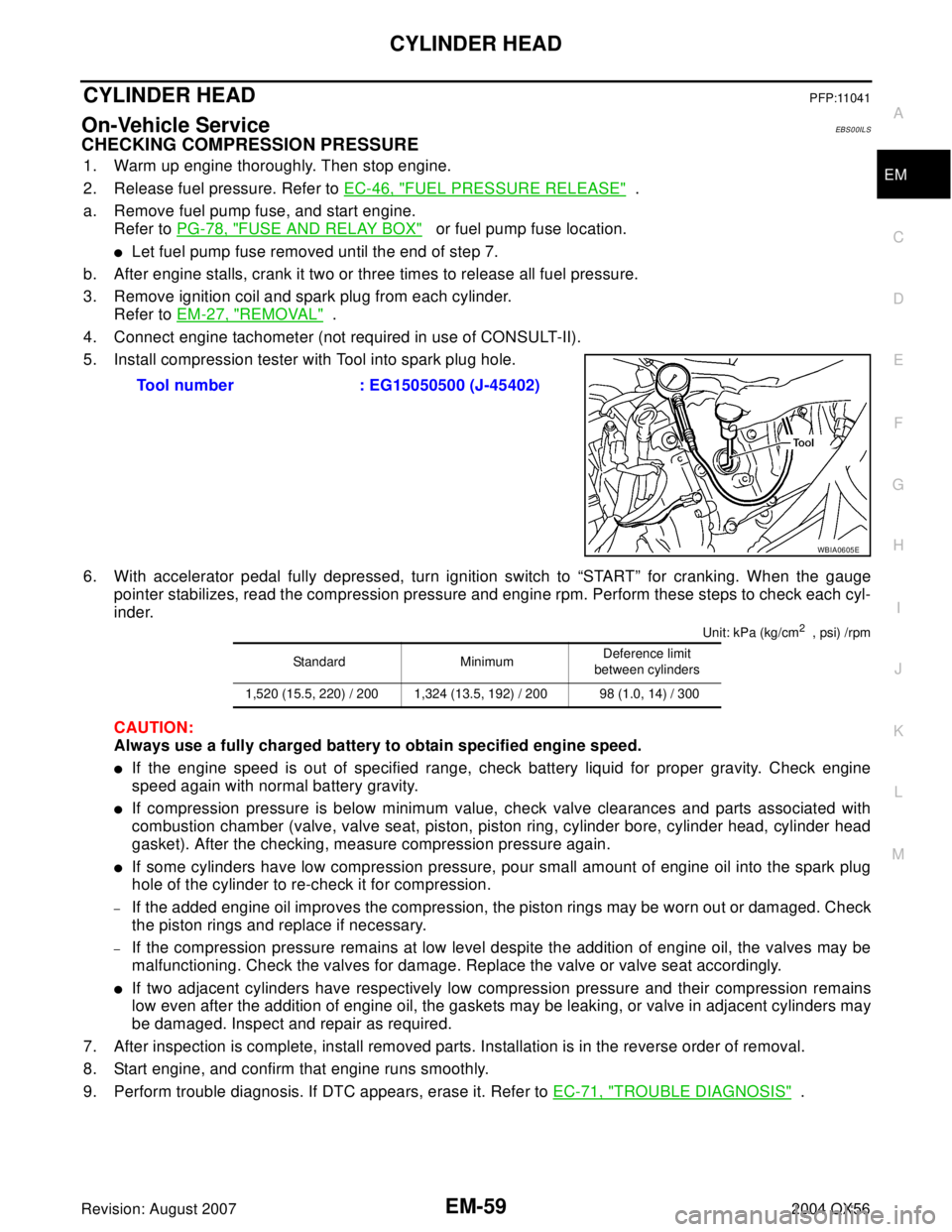
CYLINDER HEAD
EM-59
C
D
E
F
G
H
I
J
K
L
MA
EM
Revision: August 20072004 QX56
CYLINDER HEADPFP:11041
On-Vehicle ServiceEBS00ILS
CHECKING COMPRESSION PRESSURE
1. Warm up engine thoroughly. Then stop engine.
2. Release fuel pressure. Refer to EC-46, "
FUEL PRESSURE RELEASE" .
a. Remove fuel pump fuse, and start engine.
Refer to PG-78, "
FUSE AND RELAY BOX" or fuel pump fuse location.
�Let fuel pump fuse removed until the end of step 7.
b. After engine stalls, crank it two or three times to release all fuel pressure.
3. Remove ignition coil and spark plug from each cylinder.
Refer to EM-27, "
REMOVAL" .
4. Connect engine tachometer (not required in use of CONSULT-II).
5. Install compression tester with Tool into spark plug hole.
6. With accelerator pedal fully depressed, turn ignition switch to “START” for cranking. When the gauge
pointer stabilizes, read the compression pressure and engine rpm. Perform these steps to check each cyl-
inder.
Unit: kPa (kg/cm2 , psi) /rpm
CAUTION:
Always use a fully charged battery to obtain specified engine speed.
�If the engine speed is out of specified range, check battery liquid for proper gravity. Check engine
speed again with normal battery gravity.
�If compression pressure is below minimum value, check valve clearances and parts associated with
combustion chamber (valve, valve seat, piston, piston ring, cylinder bore, cylinder head, cylinder head
gasket). After the checking, measure compression pressure again.
�If some cylinders have low compression pressure, pour small amount of engine oil into the spark plug
hole of the cylinder to re-check it for compression.
–If the added engine oil improves the compression, the piston rings may be worn out or damaged. Check
the piston rings and replace if necessary.
–If the compression pressure remains at low level despite the addition of engine oil, the valves may be
malfunctioning. Check the valves for damage. Replace the valve or valve seat accordingly.
�If two adjacent cylinders have respectively low compression pressure and their compression remains
low even after the addition of engine oil, the gaskets may be leaking, or valve in adjacent cylinders may
be damaged. Inspect and repair as required.
7. After inspection is complete, install removed parts. Installation is in the reverse order of removal.
8. Start engine, and confirm that engine runs smoothly.
9. Perform trouble diagnosis. If DTC appears, erase it. Refer to EC-71, "
TROUBLE DIAGNOSIS" . Tool number : EG15050500 (J-45402)
WBIA0605E
Standard MinimumDeference limit
between cylinders
1,520 (15.5, 220) / 200 1,324 (13.5, 192) / 200 98 (1.0, 14) / 300
Page 1953 of 3371
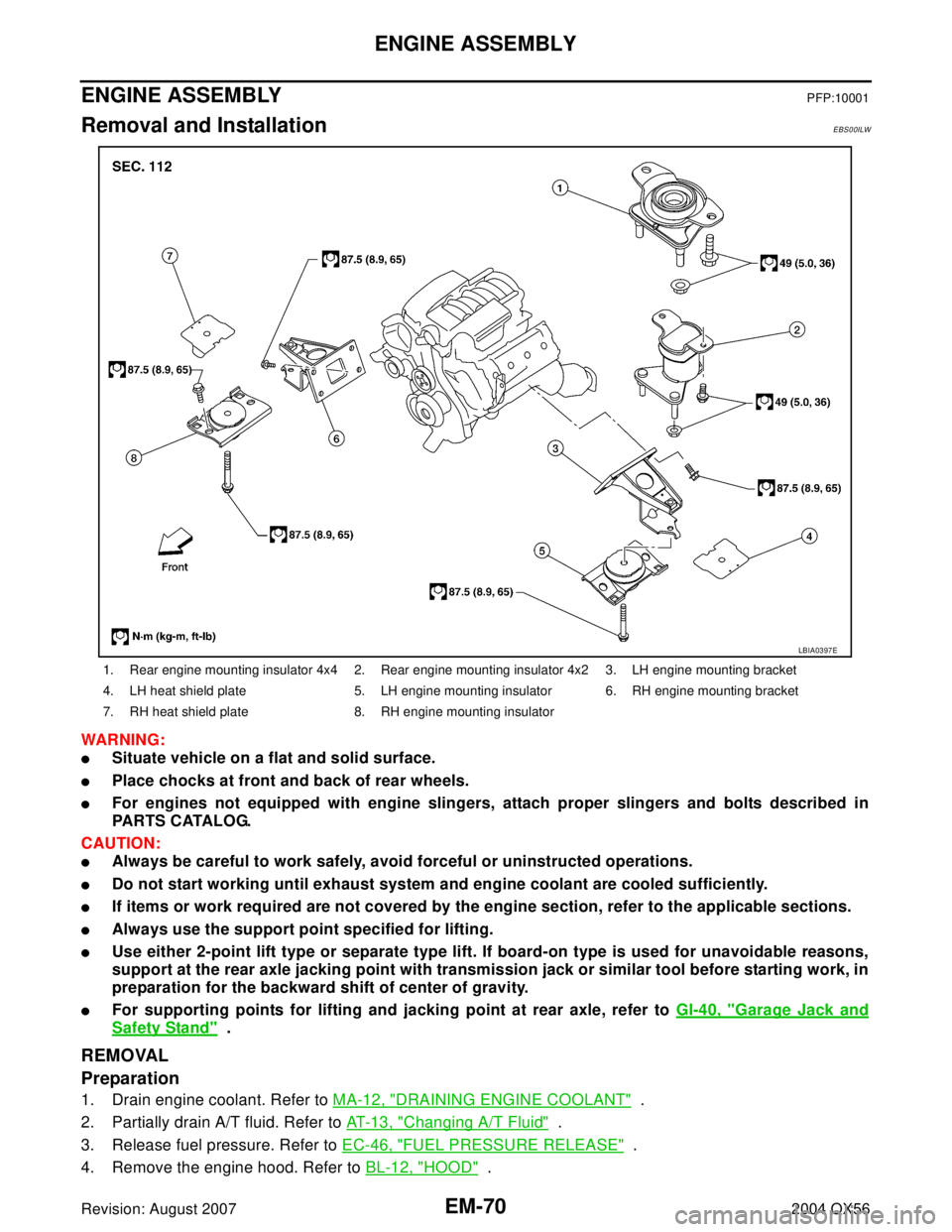
EM-70Revision: August 2007
ENGINE ASSEMBLY
2004 QX56
ENGINE ASSEMBLYPFP:10001
Removal and InstallationEBS00ILW
WAR NIN G:
�Situate vehicle on a flat and solid surface.
�Place chocks at front and back of rear wheels.
�For engines not equipped with engine slingers, attach proper slingers and bolts described in
PARTS CATALOG.
CAUTION:
�Always be careful to work safely, avoid forceful or uninstructed operations.
�Do not start working until exhaust system and engine coolant are cooled sufficiently.
�If items or work required are not covered by the engine section, refer to the applicable sections.
�Always use the support point specified for lifting.
�Use either 2-point lift type or separate type lift. If board-on type is used for unavoidable reasons,
support at the rear axle jacking point with transmission jack or similar tool before starting work, in
preparation for the backward shift of center of gravity.
�For supporting points for lifting and jacking point at rear axle, refer to GI-40, "Garage Jack and
Safety Stand" .
REMOVAL
Preparation
1. Drain engine coolant. Refer to MA-12, "DRAINING ENGINE COOLANT" .
2. Partially drain A/T fluid. Refer to AT - 1 3 , "
Changing A/T Fluid" .
3. Release fuel pressure. Refer to EC-46, "
FUEL PRESSURE RELEASE" .
4. Remove the engine hood. Refer to BL-12, "
HOOD" .
1. Rear engine mounting insulator 4x4 2. Rear engine mounting insulator 4x2 3. LH engine mounting bracket
4. LH heat shield plate 5. LH engine mounting insulator 6. RH engine mounting bracket
7. RH heat shield plate 8. RH engine mounting insulator
LBIA0397E
Page 1955 of 3371
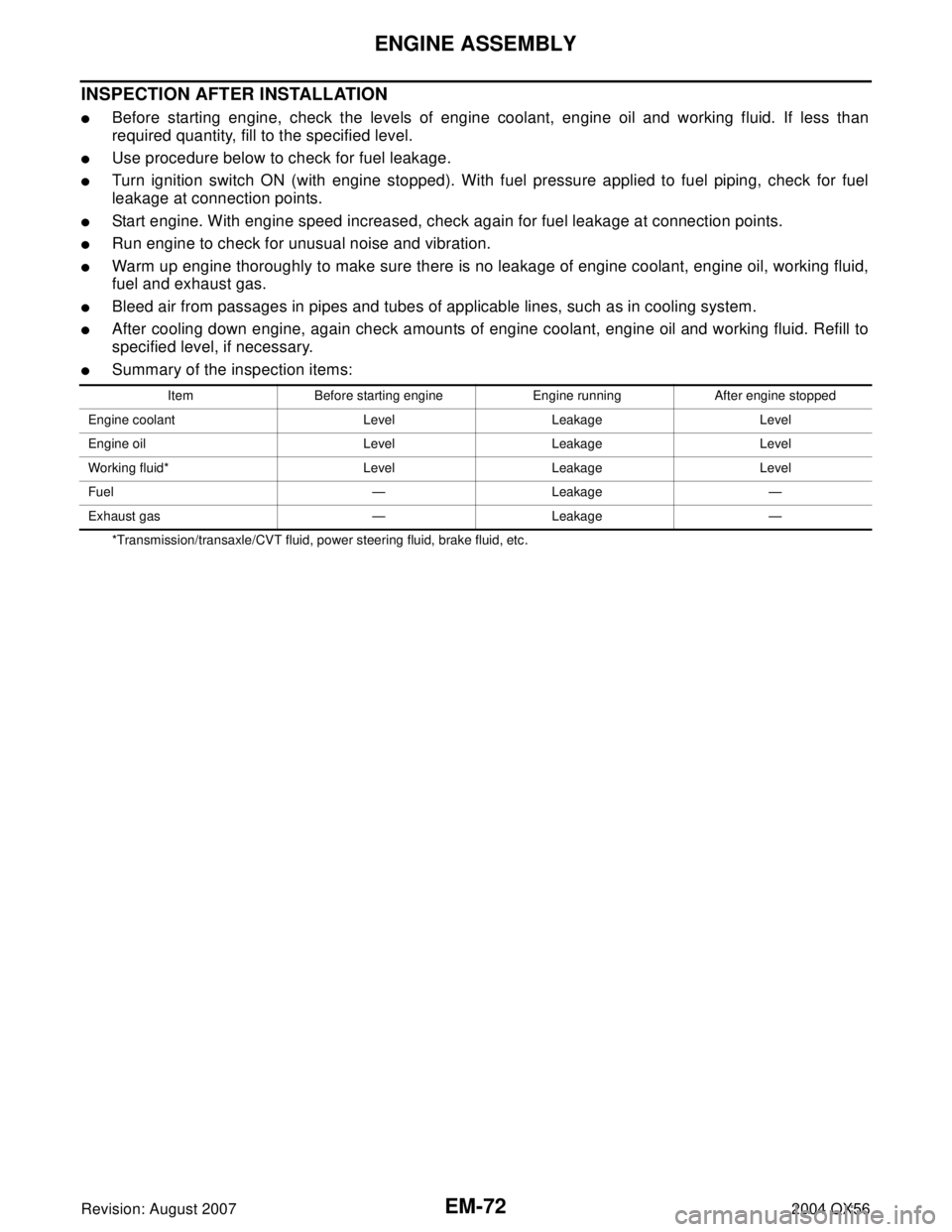
EM-72Revision: August 2007
ENGINE ASSEMBLY
2004 QX56
INSPECTION AFTER INSTALLATION
�Before starting engine, check the levels of engine coolant, engine oil and working fluid. If less than
required quantity, fill to the specified level.
�Use procedure below to check for fuel leakage.
�Turn ignition switch ON (with engine stopped). With fuel pressure applied to fuel piping, check for fuel
leakage at connection points.
�Start engine. With engine speed increased, check again for fuel leakage at connection points.
�Run engine to check for unusual noise and vibration.
�Warm up engine thoroughly to make sure there is no leakage of engine coolant, engine oil, working fluid,
fuel and exhaust gas.
�Bleed air from passages in pipes and tubes of applicable lines, such as in cooling system.
�After cooling down engine, again check amounts of engine coolant, engine oil and working fluid. Refill to
specified level, if necessary.
�Summary of the inspection items:
*Transmission/transaxle/CVT fluid, power steering fluid, brake fluid, etc.Item Before starting engine Engine running After engine stopped
Engine coolant Level Leakage Level
Engine oil Level Leakage Level
Working fluid* Level Leakage Level
Fuel — Leakage —
Exhaust gas — Leakage —